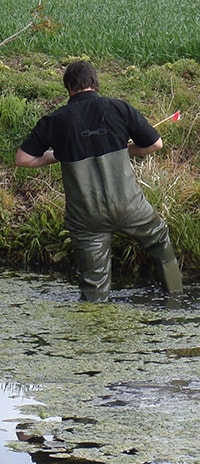Southern Ecological Solutions has a team of ecologists that have significant experience carrying out Great Crested Newt surveys and mitigation works. All SES staff possess the legally required Natural England licence to great crested newt surveys and have applied successfully for European Protected Species licence’s to carryout complex ecological mitigation works such off site translocations, habitat enhancement and newt fencing services.
With our in-house Environmental Engineers at SES we have the necessary experience and skills to carry out mitigation works such as the construction of newt ponds, terrestrial habitats, hibernacula and the installation of exclusion newt fencing under the tight legal constraints associated with working with this species. If you would like to discuss your newt survey requirements with one of our ecologists please contact us.
General Great Crested Newt Information
Habitat and Ecology of the Great Crested Newt

Great crested newts are the largest of the three newt species native to Great Britain , with adult newts growing to 15-18cm in length. The great crested newt is warty and dark, almost black, speckled with tiny white spots. The belly is orange or yellow with individually identifiable patterns of black blotches. In the spring, males develop an impressive jagged crest along their back and tail. The tail has a slivery strip along the bottom edge; contrasting with females who have an orange strip along the bottom edge.
Great crested newts are typically nocturnal and during daylight hours often take refuge under damp frost free places such as rocks, log piles, walls and underground crevices. Such frost free refuge areas are often preferred for hibernation, which typically begins in late autumn and lasts till spring; however the hibernation period can vary regionally due to the difference in weather conditions.
The great crested newt requires a diverse mosaic of terrestrial habitat for shelter and food when on land, they use corridors such as hedges and ditches to disperse from breeding ponds. They reach breeding maturity after 2-4 years upon which they will normally return to their birth pond; these ponds should contain open areas for breeding displays with emergent or submerged vegetation for egg laying and feeding opportunities (invertebrates). Pond size can vary but medium to small ponds tend to be preferred which can also be seasonally dry as this dryness helps contain the newt’s main predators such as fish.
Legal Status and Protection
The great crested newt in Britain and Europe has suffered major population declines over the last century through the loss and fragmentation of their habitat. Therefore the species is protected through both national and European legislation.
Great crested newts are protected under section 9 of the Wildlife and Countryside Act 1981 and regulation 40 of the Conservation of Habitats and Species Regulations 2010. Taken together it is illegal to:
- Deliberately kill, injure or capture any wild animal of European protected species;
- Deliberately disturb wild animals of any European protected species in such a way to be likely to significantly affect:
- The ability of any significant groups of animals of that species to survive, breed, rear or nurture their young; or
- The local distribution of that species.
- Recklessly disturb a European protected species or obstruct access to their resting places;
- Damage or destroys breed sites or resting places of such animals;
- Deliberately takes or destroys the eggs of such an animal;
- Possess or transport or any part of a European protected species, unless acquired legally;
- Sell, barter or exchange any part of a European protected species.
The maximum fine per offence is £5000 the Countryside and Rights of Way Act 2000 (CROW) amendment contains a provision for a custodial sentence of up to 6 months instead of, or in addition to, a fine. Along with a lengthy development delay until an appropriate mitigation programme has been agreed and completed.
Natural Environment and Rural Communities Act 2006 (NERC) also lists the great crested newt as a species of principle importance under Section 41 and Section 40 requires every public body in the exercising of its functions (in relation Section 41 species) to ‘have regard, so far as is consistent with the proper exercise of those functions, to the purpose of conserving biodiversity’; therefore making great crested newts a material consideration in the planning process and requiring a detailed ecological survey before planning permission can be granted. In addition, local authority planning departments should also meet the requirements of chapter 11: Conserving and enhancing the natural environment, of the Nation Planning Policy Framework; which requires planners not only to protect biodiversity, but where possible to enhance it.
Great Crested Newt Survey Requirements
Traditional survey techniques such as netting and bottle trapping must be conducted by a licensed individual. As newts are largely nocturnal, surveying is best conducted at night following Natural England guidance, and during the breeding period of mid-March to mid-June. The survey process requires four visits to determine presence or absence, or six visits to estimate population size class. In either case, at least 2 of the visits must take place between mid-April and mid-May. However, Habitat Suitability Indexes (HSI) can be undertaken without a licence, can be conducted at any time of the year, and can be used as a predictive tool for GCN presence or likely absence. In addition SES can undertake environmental DNA (eDNA) sampling to detect the presence of GCN. This ground-breaking technique is subject to strict timing requirements but can potentially reduce the amount of traditional survey effort required and associated costs.
Great Crested Newt Mitigation
The presence of great crested newts is a material consideration in the planning process (NERC Act 2006), and development plans should take the presence of ponds into account. Actions which are prohibited by legislation can be made legal by the granting of an appropriate Natural England licence. In order to obtain a licence to allow for example the capture of newts or destruction of breeding sites in advance of any otherwise legitimate development, a licensed great crested newt survey is thus required.
Habitats Regulations Assessment (HRA)
The Conservation of Habitats and Species Regulations 2010 transposes the Habitats Directive into UK law, and outlines a system for assessing the effects of a project on Natura 2000 sites (Special Protection Areas, Special Areas of Conservation and Ramsar sites).
A Habitats Regulations Assessment consists of two initial stages:
- Screening for likely significant effects (likely significance test)
- Appropriate assessment (and integrity test).
The ‘competent authority’ (which is normally the planning authority) undertakes the formal assessment of the above tests with SES providing robust data and analysis to ensure the assessment can be completed.
SES ecologists have significant experience in providing initial advice to our clients on whether a Habitats Regulations Assessment is likely to be required in the first instance. As well as the gathering of robust data, provision of analysis, and mitigation recommendations if required for any assessment by the competent authority.



